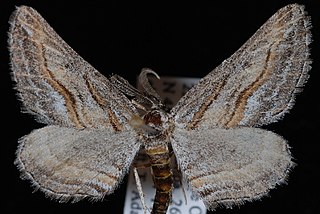
Hulstina is a genus of moths in the family Geometridae erected by Harrison Gray Dyar Jr. in 1903.

Eudonia echo is a moth of the family Crambidae described by Harrison Gray Dyar Jr. in 1929. It is found in western North America from British Columbia to California.

Harrison Gray Dyar Jr. was an American entomologist. Dyar's Law, a pattern of geometric progression in the growth of insect parts, is named after him. He was also noted for eccentric pursuits which included digging tunnels under his home. He had a complicated personal life and along with his second wife he adopted the Baháʼí Faith.
Homoeosoma striatellum is a species of snout moth in the genus Homoeosoma. It was described by Harrison Gray Dyar Jr. in 1905. It is found in North America, including Arizona, California and Nevada.
Donacaula nitidellus is a moth in the family Crambidae. It was described by Harrison Gray Dyar Jr. in 1917. It is found in North America, where it has been recorded from Alberta, Alabama, Connecticut, Georgia, Maryland, Massachusetts, Mississippi, New Jersey, New York, North Carolina, South Carolina and Texas.
Cosipara stereostigma is a moth in the family Crambidae. It was described by Harrison Gray Dyar Jr. in 1918. It is found in Xalapa and Orizaba, Mexico and Guatemala.

Eudonia albertalis is a moth in the family Crambidae. It was described by Harrison Gray Dyar Jr. in 1929. It is found in North America, where it has been recorded from Alberta to British Columbia, Washington, Idaho and Wyoming.
Eudonia crassiuscula is a moth in the family Crambidae. It was described by Harrison Gray Dyar Jr. in 1929. It is found in Brazil (Paraná) and French Guiana.
Eudonia excursalis is a moth in the family Crambidae. It was described by Harrison Gray Dyar Jr. in 1929. It is found in Costa Rica.
Eudonia inexoptata is a moth in the family Crambidae. It was described by Harrison Gray Dyar Jr. in 1929. It is found in Mexico.

Eudonia leucophthalma is a moth in the family Crambidae. It was described by Harrison Gray Dyar Jr. in 1929. It is found in North America, where it has been recorded from British Columbia and Alberta to Washington and California.
Eudonia vinasalis is a moth in the family Crambidae. It was described by Harrison Gray Dyar Jr. in 1929. It is found in Costa Rica.
Scoparia albipunctata is a moth in the family Crambidae. It was described by Herbert Druce in 1899. It is found in Costa Rica and Guatemala.
Scoparia denigata is a moth in the family Crambidae. It was described by Harrison Gray Dyar Jr. in 1929. It has been recorded from the US state of Arizona.
Scoparia multifacies is a moth in the family Crambidae. It was described by Harrison Gray Dyar Jr. in 1929. It is found in Guatemala and Xalapa, Mexico.
Scoparia normalis is a moth in the family Crambidae. It was described by Harrison Gray Dyar Jr. in 1904. It has been recorded from the US states of Arizona, Colorado, New Mexico, North Carolina and Utah.
Scoparia ulmaya is a moth in the family Crambidae. It was described by Harrison Gray Dyar Jr. in 1929. It is found on the West Indies, where it has been recorded from Guadeloupe.
Wellesca Pollock Allen Dyar was an American educator and an early adherent to Baháʼí Faith in the United States. She was at the center of a Washington, D. C. society scandal in 1916.
Lacosoma arizonicum, the southwestern sack-bearer moth, is a species of moth in the family Mimallonidae and one of four species of sack-bearers occurring north of Mexico. Its type locality is the Chiricahua Mountains of Arizona. The species was first described by Harrison Gray Dyar Jr. in 1898 from a single male specimen and has Hodges number 7660.

John Bernhardt Smith was an American professor of entomology who specialized in systematics and economic entomology while also serving as the State Entomologist of New Jersey. Smith is remembered in insect taxonomy for the conflict that he had with Harrison Dyar.





